Single Board Computers or SBCs are slowly becoming the favorite toys of every technologically-driven tinkerer or hobbyist. Reason? With an SBC, you use a tiny form factor to achieve extensive functionalities. The main features that comprise an SBC include the IO ports, memory, GPU, and CPU. These features exist or are grounded on a small circuit board. These physical traits of an SBC do not depict it as compact but rather extensive. An SBC user can stretch this powerful circuit board’s functionality by integrating it with other electronic devices via the provided IO ports.
The most prominent SBCs you can probably relate to based on the above description are the Arduino and Raspberry Pi SBC products. For this article, the Arduino board seems underqualified when reviewed independently. It qualifies as an effective AI and DL project contributor when integrated with the other AI and DL performant single board computers.
The current world narrative on AI (Artificial Intelligence) and DL (Deep Learning) does not depict the Arduino and Raspberry Pi SBCs as the only qualified candidates. More SBCs are already meeting the qualifications of standardized edge computing in the fields of AI and DL.
The SBCs that this article considers performant in AI and DL are listed in no particular order. The aim or objective of the article is to provide you as the reader with enough insight on how you can navigate the world of AI and DL without being limited to specific SBCs that are yet to attain the needed functional maturity.
Conceptualizing AI (Artificial Intelligence) and DL (Deep Learning)
Think of any human-related task. Can it be automated? If the answer is yes, then it qualifies as an AI-achievable project. AI uses numerous tools, algorithms, and systems to recreate these human-related tasks. When we bring Deep Learning into this fold, we describe an AI advanced functionality.
Think of DL as an AI evolution. When AI is concerned with mastering the automation of human-related tasks, DL is concerned with the concepts of bettering this automation process. It tries to mock the functional implementation of the human brain. For this reason, the AI process underway can exhibit decision making, language translation, speech recognition, and object detection. DL is an AI that is performant outside human supervision. It can process both unlabeled and unstructured data without the need for third-party assistance.
Electronic hardware qualifications for AI and DL
The AI and DL SBCs this article will review fall under the category of hardware architecture and optimization processing power. This hardware’s characterization needs to meet certain performance traits like security, connectivity, energy efficiency, and processing capacity.
An SBC chipset product that wants to qualify as AI and DL efficient must consist of accelerators, GPU (Graphical Processing Unit), FPGA (Field Programmable Gate Array), CPU (Central Processing Unit), ASIC (Application-Specific Integrated Circuit), RISC(Reduced Instruction Set Computer), and NNP (Neural Network Processors). The implementation of these chipsets is categorical. You will find others efficient in dedicated edge processing, others efficient as cloud computing servers, and others as autonomous hardware in ML (Machine Learning) platforms and automobiles.
An SBC hardware can qualify as an AI and DL training platform, an AI and DL computational framework, or both. The current AI-based SBCs are packaged with compiled DL, ML, and CV (Computer Vision) libraries. They make the use and implementation of these electronic hardware boards less complicated. A few mentions of these libraries include sci-kit-learn, GPU4Vision, OpenCV, and OpenVIDIA. A notable library for creating 3D computer-generated objects through an SBC is none other than the open-source OpenGL graphics library.
With this API library, you will be making use of graphics accelerators. They make scene rasterization flawlessly fast. If you are pursuing parallel computing through the SBCs this article will discuss, it will be worth mentioning the open-sourced OpenCL library. It is strongly vouched for as a parallel computing standard applicable in heterogeneous computing environments. Such an environment comprises the use of special accelerator devices, GPUs, CPUs, and FPGAs. Another prominent open-source library you should keep in mind for your SBC projects is OpenCV. It is effective in the visual analysis of images and videos through library tools like CUDA, DirectX, OpenCL, and OpenGL. OpenCV interfaces include Python, C, and C++, which further attribute its cross-platform nature. The OpenCL library will also help you meet your multi-core processing needs.
10 best AI and DL single-board computers
We now know something about SBCs, their hardware qualifications, and their optimal operation specs. Time to list down these SBCs fictional characters and give them a live review.
1. Raspberry Pi 4 (RPi 4)
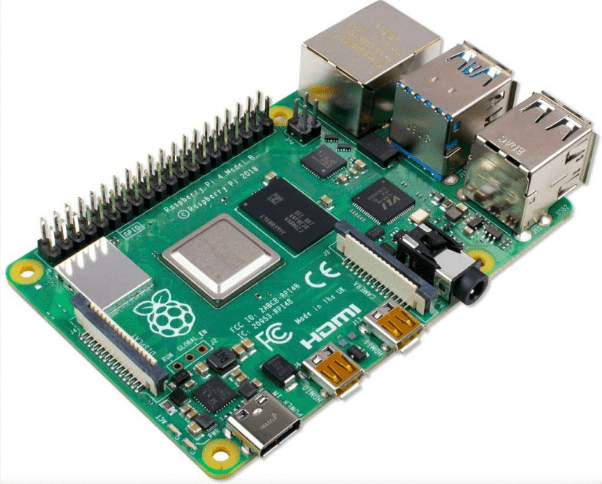
Raspberry Pi 4 as an AI and DL Single Board Computer
We found it ideal to start this article’s SBCs review with a familiar face. The launch of Raspberry Pi 4 had one objective in mind, embedded IoT and AI. Any mention of AI automatically encapsulates DL since the latter cannot exist without the former. With an estimated price tag of $35, this electronic board’s cost-effective attribute makes it the most popular Single Board Computer. Raspberry Pi 4 has strong support from its user community. Its release is packaged with a rich and well-documented user manual to get any user up-to-speed on how to begin their Raspberry Pi adventure. It is functionally described as a revamped SoC (System-on-a-Chip). The Raspberry Pi 4 hardware specs present the options of 2GB, 4GB, or 8GB DDR4 RAMs to its users. Such hardware specs and ranges make the board ideal for AI-based projects.
Some project ideas that can be flawless under Raspberry Pi 4 include object detection and image classification. To gauge the performance prowess of Raspberry Pi 4, you can test its responsiveness to an open-source Machine Learning library like TensorFlow and compare it to Raspberry Pi 3. The processing power of Raspberry Pi 4 will be much faster than that of its predecessor. Its support for USB 3.0 ports is a drastic performance improvement.
Raspberry Pi 4 is complemented by AI-supported third-party accessories. For example, your Raspberry Pi 4 can be plugged with the Intel Neural Compute Stick 2 via USB connectivity. This third-party accessory is ideal for facilitating the provision of an artificial intelligence framework. Another alternative third-party accessory is the Coral Edge TPU USB accelerator. It is an ideal pairing device for your Raspberry Pi board. Another awesome device to pair with your Raspberry Pi board for AI and DL projects is Google’s AIY Vision and Voice kits.
This pairing is ideal for home-based projects related to autonomous vehicles or automobiles and object identification systems that improve home security systems’ design prospects. The coordination and support of Raspberry Pi 4 with these third-party accessories make it a reputable AI and DL candidate.
Some of the pros that make the Raspberry Pi 4 board ideal for AI and DL include its OS compatibility, its small footprint, ease of use, affordability, low power draw, an acceptable price-to-performance ratio, support for different RAM options, and versatility. The only drawback we can think of relates to the existence of other more performant SBCs that we are soon going to review. Its performant and miniature nature does not make it a valid Desktop computer replacement.
Some of the performance specs of this SBC include its 0-50 degrees Celsius ambient operational temperature, enabled Power over Ethernet (PoE) support, OpenGL ES 3.0 graphics, Gigabit Ethernet, and 2 USB 2.0 ports and 2 USB 3.0 ports.
2. NVIDIA Jetson Xavier NX
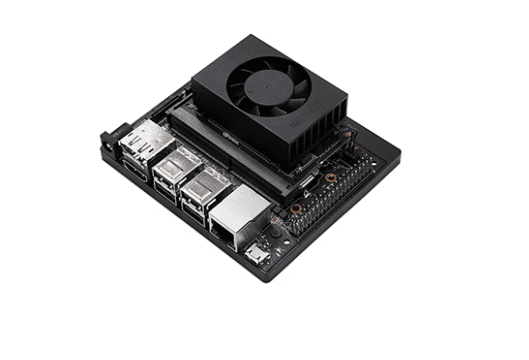
Nvidia Jetson Xavier NX as an AI and DL Single Board Computer
If this article were about ranking Single Board Computers based on performance, then Nvidia Jetson Xavier NX would undoubtedly be a top candidate on this list. Despite being the smallest AI and DL supercomputer in the world, based on popular opinion, the performance of this SBC knows no limit. It is boastful of its processing power of 21 Tera Operations Per Second (TOPS) on a 15W power supply. If we were to reduce this power supply to around 10W, Nvidia Jetson Xavier NX would still clock an operational computation of around 14 TOPS. Nvidia Jetson Xavier NX markets itself as both an energy-efficient and computationally powerful Single Board Computer. Its 70-45 mm footprint depicts it as ultra-small. Despite its small size, its spec sheet presents an impressive glaring site. It packs 48 Tensor cores and 384-core NVIDIA Volta GPU for its 6-core NVIDIA Carmel ARM v8.2 64-bit CPU.
Under a benchmarking test performance review, the younger siblings of this Single Board Computer, Jetson TX2, and Jetson Nano, were no match for its performance power and prowess. Regardless of this Single Board Computer’s performance impression, its price tag is not as friendly, for you will need an estimate of $400 to acquire this powerful SBC. Its SBC siblings, like Jetson Nano, are sold at an affordable $59 price tag. These price range differences do not make either of the SBC overqualified or underqualified for AI projects. You have to be specific with your AI project’s objectives. If the project is less demanding, you are safe in Jetson Nano’s hands. If you are looking for supercomputer capabilities and functionalities, you have no option but to go after the Nvidia Jetson Xavier NX Single Board Computer.
The pros of this SBC include its AI-capable adaptation to concepts like Natural Language Processing and Machine Learning. It is excellent for robotics projects and creates an ideal desktop usage environment. Other additional pros include small form factor, 4K video output, a maximum of 21 TOPS computing power, high-end retro gaming emulation, and its inclusion and support of HDMI/Display Port, GPIO, USB 3.1, Bluetooth, Wi-Fi, and I/O ports. The notable drawbacks of dealing with this SBC are its size which makes it larger compared to alternatives like Raspberry Pi 4. Its hefty price tag does not sway users to purchase it easily.
3. NVIDIA Jetson Nano
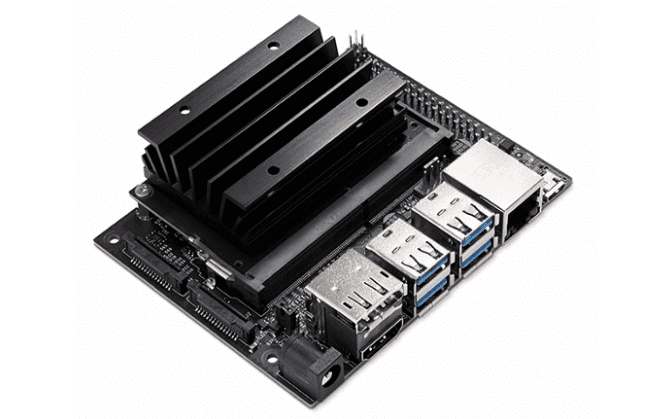
Nvidia Jetson Nano as an AI and DL Single Board Computer
As mentioned, this SBC is a direct sibling to Nvidia Jetson Xavier NX. Its market asking price is friendly than that of Nvidia Jetson Xavier NX. You only need an estimated budget of $59 to acquire a piece of this SBC hardware. With this price tag, its cost-to-execution ratio is decent enough. This piece of hardware is ideal for running numerous neural-related AI processes. Some examples of these AI app processes include picture characterization, discourse handling, division, and object location.
If you are an AI devotee, hobbyist, specialist, or designer looking for a breakthrough in actualizing your AI projects, then look no further than the Nvidia Jetson Nano SBC.
The currently available Jetson Nano SBCs in the electronics marketplace are offered to its community users in two Main Memory or RAM variations. One is operable through 2GB RAM and the other through 4GB RAM. The Jetson Nano screenshot above is for the 4GB SBC. The main difference between these two SBC hardware variations is their performance value. A 4GB powered hardware will always outsmart a 2GB powered hardware at any time given that they are operating at an equivalent processor hardware power.
The key notable specs of Nvidia Jetson Nano include microSD card storage support, HDMI display, 128-core NVIDIA Maxwell GPU, Quad-core ARM A57 @1.43 GHz CPU, and 2GB 64-bit or 4GB 64-bit memory.
4. NVIDIA Jetson AGX Xavier
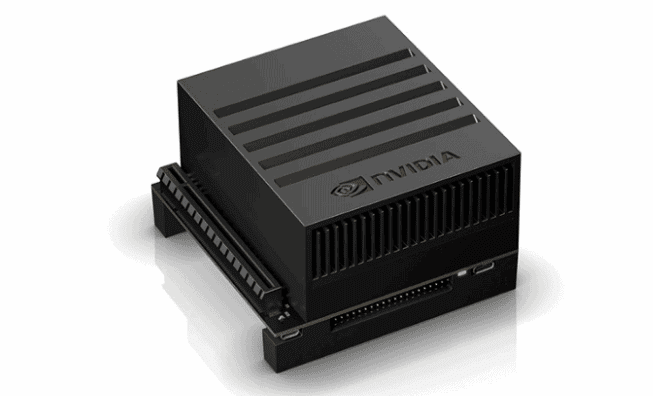
Nvidia Jetson AGX Xavier as an AI and DL Single Board Computer
This is the most expensive SBC sibling in the NVIDIA family. We can estimate its market price tag at around $694.91. Some might consider its price tag to be too high, but it is a deserved market attribute based on the functionalities and workloads it can handle. The operational objective of this SBC board is to convey or integrate it with worker applications and AI mechanical technologies in the business world or industry.
This SBC board is flexible enough to adapt to business or industrial circumstances related to horticulture, automobile upgrades and manufacture, retailing, and production. Many other business and industrial circumstances exist where you will need the priceless input of the Nvidia Jetson AGX Xavier SBC.
With that said and also considering the commanding price tag of this SBC, Nvidia Jetson AGX Xavier is not a board for fledgling or exploration. The SBC’s design and functional power make it ideal for engineers that are after top-level edge and figure execution project outcomes. Organizations, businesses, or companies that are after great software and hardware application versatility will never feel the disappointment of choosing to work with Nvidia Jetson AGX Xavier.
Some notable key specifications of this SBC include HDMI 2.0 display, 32GB eMMC 5.1 storage with an optional storage expansion UFS/ uSD Card Socket, 7-Way VLIW Vision Processor Vision Accelerator, 2x NVDLA Engines DL Accelerator, Tensor Cores-supported 512-core Volta GPU, and 64-bit 8-core ARM v8.2 CPU.
5. Google Coral Dev Board

Google Coral Dev Board as an AI and DL Single Board Computer
The functional design and implementation of this SBC make it ideal for Deep Learning through Artificial Intelligence. If your AI projects need to attain a fast, easy, and edgy computing prototyping functionality, then you need the niftiness of the Google Coral Dev Board SBC. One of the notable traits you will find on this Single Board Computer is its removable system-on-module. Another trait of this SBC is its ideal TOPS (Tera Operations Per Second) figure, which stands at 9 TOPS.
The measurement of this SBC’s TOPS is per watt. These two mentioned traits adapt the Google Coral Dev Board’s use to low-cost AI and DL projects. The core of this SBC contains an NXP i.MX 8M SoC (System-on-a-Chip). A GC7000 Lite GPU is integrated with this SoC. A further evaluation of this SBC board also reveals WiFi and Bluetooth hardware, 1GB LBDDR4 RAM, 8GB eMMC flash storage, and a Google Edge TPU co-processor.
Together with this SBC’s low power draw, these hardware traits make the Google Coral Dev Board easily scalable for industrial AI applications. The informative nature of this Coral Dev Board’s SBC documentation qualifies it as a priceless user manual for individuals seeking to explore the Ins and Outs of its functional design. The documentation also covers the implementation of this SBC’s Mendel Operating System. Aside from its detailed documentation, this Google Coral Dev Board’s existence is linked with rich help documents from the user communities and a resourceful library of sample projects to get anyone started on mastering the use of this electronic hardware board.
Supported add-ons for this SBC also help improve a user’s modular experience. One such modular-enriching add-on is the Coral Camera. On this note, we would not recommend the Google Coral Dev Board as an ideal SBC for newcomers or explorers. Its purposeful and direct functional design makes it ideal for matured or experienced artificial intelligence enthusiasts. If you are looking for hands-on experience in AI and DL, then a good starting point is exploring Google Coral USB TPU accelerator and Raspberry Pi 4 Plus.
Some notable pros on Google Coral Dev Board include Edge TPU on-device machine learning, 1GB DDR4, and the quad-core Cortex A-53 SoC as its powerhouse. One of the notable drawbacks is its $129.99 price tag. It is also underqualified as a desktop computer.
6. Google Coral Dev Board Mini
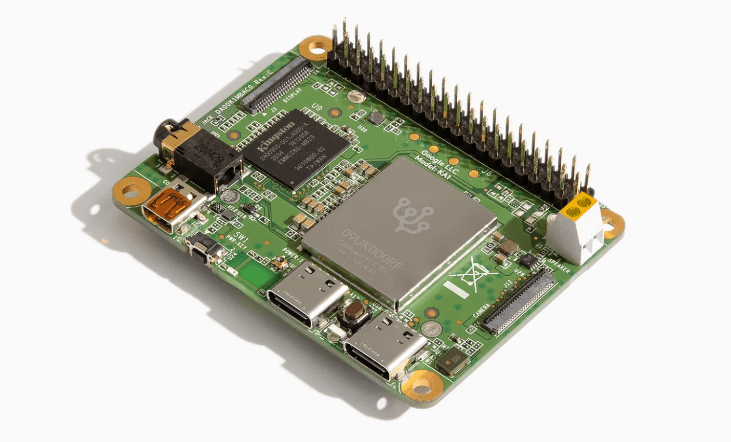
Google Coral Dev Board Mini as an AI and DL Single Board Computer
This SBC came into existence to succeed the Google Coral Dev board. Its $99.99 lowered price tag is an avoidable bait to the users saving to acquire its predecessor. It is attributed to a smaller form factor and a higher processing power.
Some key Google Coral Dev Board Mini specs include 8GB eMMC storage, 2GB LPDDR3 RAM, IMG PowerVR GE8300 GPU, Google Edge TPU coprocessor ML Accelerator, 4-core Arm Cortex-A35 CPU, and a micro HDMI Display.
7. Rock Pi N10
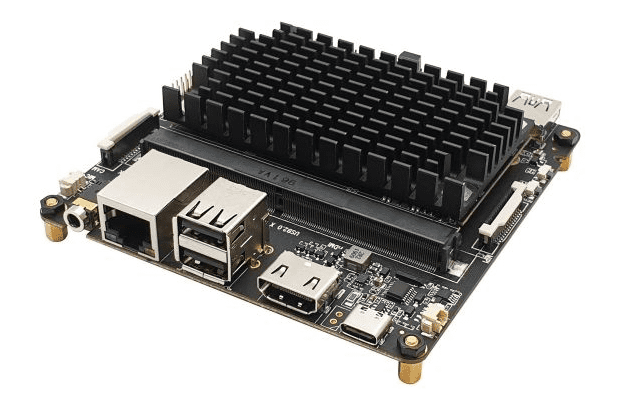
Rock Pi N10 as an AI and DL Single Board Computer
The design and development of this Single Board Computer directly conceptualized Artificial Intelligence and Deep Learning ideology beforehand due to the hardware specs it brings to the table. It boasts of its LPDDR3 RAM options of 4GB, 6GB, and 8GB. Its NPU design on Rockchip RK3399 is geared primarily for AI and DL. This hardware platform also extends its support for other operating systems like the Android Operating Systems and the Linux Operating Systems that fall under Debian distribution.
For storage, it offers a microSD card slot. Rock Pi N10 also considers an M.2 SSD connector as part of its hardware attribute. This connector offers an SSD storage support of up to 2TB. This SBC is not integrated with a WiFi hardware module, but you can use the Rock Pi wireless module to achieve this objective. Its 40-pin General Purpose Input-Output (GPIO) header meets all your project Input/Output (I/O) needs. Its $100 price tag is ideal enough for hobbyists seeking to explore the AI and DL world on a limited budget.
Its notable pros include M.2 SSD connector, 16GB eMMC, 8GB DDR3, 3.0 TOPS dedicated NPU, and 4K@60 full-size HDMI support. The notable cons are its lack of support for DDR4 and the absence of a built-in Bluetooth or WiFi module.
8. HiKey 970
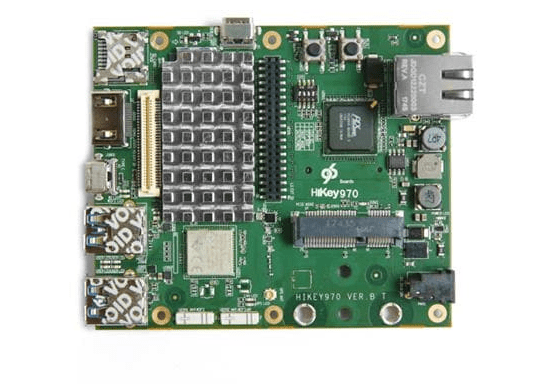
HiKey 970 as an AI and DL Single Board Computer
The design and implementation of this SBC hardware board are perfected for Artificial Intelligence projects. Its hardware presentation reveals an NPU, HiAI architecture, and HiSilicon Krin 970 SoC. Other additional hardware modules packaged with this SBC include GPS, WiFi, Bluetooth, 64GB UFS 2.1 storage, and LPDDR4X 1866MHz RAM. This SBC hardware also extends its support to Linux-based and Android-based operating systems.
Despite its $300 price tag and strongly suited for AI-based projects, it qualifies as a worthy AI and DL candidate, especially for users leaning towards robotics projects.
Its notable pros include its AI-dedicated NPU, PCIe gen2, GPS, Gigabit Ethernet connectivity support, 64GB UFS storage, quad-core cortex-A53, and quad-core Cortex-A73 processors, 6GB LPDDR4 RAM, and its hardware embrace of robotics, Deep Learning, and AI. The only notable con is its $300 price tag.
9. BeagleBone AI SBC
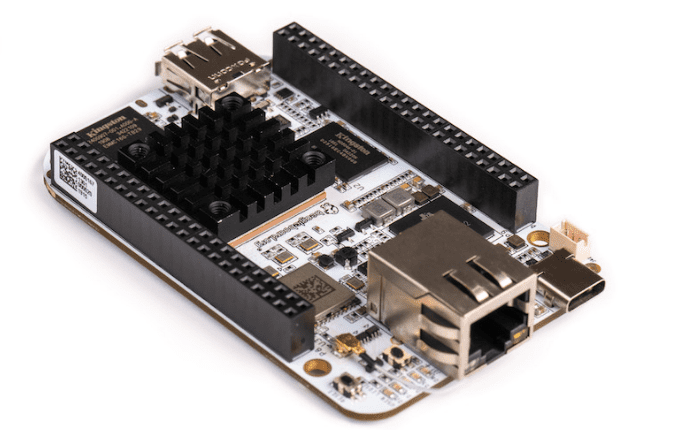
BeagleBone AI SBC as an AI and DL Single Board Computer
This Single Board Computer hardware also qualifies as an ideal candidate for AI and DL. It is richly feature-packed and mimics the Linux approach, which attributes it as an open-source platform. This attribute makes it a perfect intermediary for bridging the gap between expensive supercomputers and low-power tiny SBCs. Some of its boastful features include 2 C66x floating-point VLIW DSPs, Dual ARM Cortex A-15 microprocessor, dual-core programmable real-time unit, four embedded vision engines, and dual-core PowerVR SGX544 3D GPU.
BeagleBone AI, with the functional implementation of OpenCL API, will facilitate Machine Learning through its embedded-vision-engine and digital0signature-processor. The SBC is a great project facilitator for users seeking to explore home-based and industrial AI and DL applications.
Some notable pros of this SBC include its reasonable pricing ($127.43), compatibility with Debian-based Linux distributions, OpenCL API compatibility, dual-band WiFi and Gigabit Ethernet connectivity, and the fact that its processing power can comfortably accommodate Machine Learning through its industrial communication system and programmable real-time unit. The only notable drawback is that other cheaper SBCs in the market can outperform BeagleBone AI’s computation power.
10. BeagleV
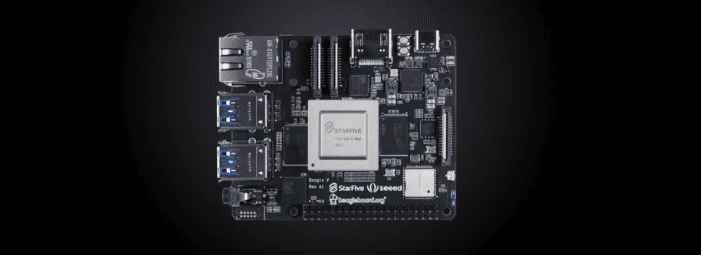
BeagleV as an AI and DL Single Board Computer
This Single Board Computer is a new candidate in this electronics board hardware list. It offers out-of-the-box support for Linux operating system distributions. If your AI and DL projects are looking for a taste of edge computing, BeagleV effortlessly relays this functionality. It enters the SBC market as a 4GB variant priced at $119 and an 8GB variant priced at $149.
Some of its key specs worth mentioning include HDMI 1.4 display, microSD slot storage support, 4GB/8GB LPDDR4 SDRAM, Neural Network Engine (NPU), NVDLA Engine 1-core DL accelerator, Vision DSP Tensilica-VP6, and RISC-V U74 2-Core @ 1.0GHz CPU.
Final Note
You will note that most of the Single Board Computers you pursue your AI and DL projects are either inexpensive and underpowered or expensive and powerful. The SBC choice you make depends on whether you are well versed with AI or are still making baby steps. Development boards like Google Coral Dev Board and NVIDIA Jetson Xavier are AI-ready for implementation upon their purchase.
Other development boards like the famed Raspberry Pi 4 will require the assistance of add-ons like Intel Neural Compute Stick or Google Coral TPU Accelerator to achieve Deep Learning or Machine Learning through AI. It is advisable for beginners still learning the ropes of AI and DL to consider the Raspberry Pi SBC together with the mentioned add-ons for their first AI projects. Advanced users who know and understand what they are doing should try SBCs like HiKey 970 and BeagleBone AI.
